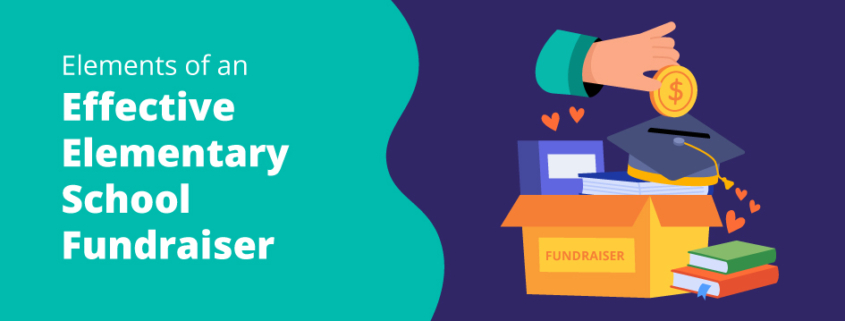4 Elements of an Effective Elementary School Fundraiser
From field trips to libraries to sports equipment, fundraisers support a wide variety of programs that make your school a place where students can learn and thrive. However, experienced school fundraisers know that launching a successful fundraising campaign is easier said than done, and that just a few core elements can make all the difference.
To help your elementary school’s next fundraiser go off without a hitch, this guide will break down four essential components of a successful school fundraiser and how to implement them.
1. Clear Goals
When it comes to fundraising goals, you may think the answer is obvious: your school wants to raise money for its programs, of course. However, goals like this often lack clarity about what success looks like, which makes executing an organized fundraiser and gathering useful data from it a challenge.
OneCause’s guide to fundraising event planning suggests setting SMART goals, which are:
- Specific. Instead of your goal being “to host a successful fundraiser,” you should specify what that fundraiser is, how much you aim to raise, and what you will use the funding for. For example, a specific goal would be something like, “At this year’s annual Walk-A-Thon, our goal is to raise $15,000 that will be put toward purchasing new equipment for our school’s sports teams.”
- Measurable. While you might also have qualitative goals, like establishing trust and connections in your community, your school should aim to establish concrete, quantifiable goals when possible. For example, you might translate building community connections to “Expanding our mailing list by 20% and starting five new partnership conversations with local organizations.”
- Achievable. Challenging goals can help your school grow, but impossible goals can depress your team. Assess your past fundraisers’ achievements to set goals that are ambitious yet feasible.
- Relevant. Ensure your goal is relevant to your school and immediate goals. Being able to explain exactly why and how a fundraiser supports your school can help you get buy-in from donors.
- Time-bound. Even if your school accepts donations all year-round, each fundraiser should have a definitive endpoint. This allows you to assess its overall impact and results.
Once you have a clear goal, break it into a series of smaller, individual aims. These should be specific tasks, like “assemble a fundraising team” or “research fundraising software.” These help you stay on track and can make a large, challenging goal seem feasible.
2. Fundraising Ideas That Excite Students
If your fundraising idea aligns with students’ interests, you’ll have a far easier time attracting participants and volunteers. For instance, one popular fundraiser for elementary school students is hosting a Read-A-Thon.
Read-A-Thon’s guide to these fundraisers explains how they work and can inspire a love of reading in students. The guide also recommends the following tips to make your fundraiser a success:
- Use a Read-A-Thon platform. Modern Read-A-Thons can highly benefit from being taken online. With a virtual Read-A-Thon platform, students can update their reading progress no matter where they are, and don’t need to worry about losing paper tracking sheets for donations and their reading progress.
- Choose a prize model. While some students will participate due to their natural love of reading, it doesn’t hurt to incentivize them by implementing a prize model. For example, reward students who read or raise the most with prizes like gift cards, books, and games.
- Measure student progress. Read-A-Thons are incredibly effective fundraisers due to how they essentially run themselves after your initial launch. However, this doesn’t mean you should be completely hands-off. Throughout your Read-A-Thon, check in on your fundraising progress to adjust your goals, encourage students, and share updates with your community.
Essentially, a Read-A-Thon succeeds as a fundraiser due to its accessibility, connection to activities students and families already support, and potential for prizes to increase motivation. When choosing a fundraising idea for your elementary school, consider your students and community’s interests.
3. Easy Participation
Elementary school fundraisers rely heavily on support from your community and school staff. However, teachers and families of young children lead busy lives, and it can be difficult to squeeze in more than a handful of hours a week to help your fundraiser.
Meet your community where they’re at by making your fundraiser as easy to participate in as possible. For example, to make planning your fundraiser easier on your volunteers, you might leverage pre-made templates and software with out-of-the-box functionality. While platforms with extensive customization can be useful, prioritizing solutions that promise speed and ease of use is just as valid.
Additionally, the more flexible your fundraiser is with how individuals participate, the more participants you’ll attract. For instance, you could host a hybrid fundraiser that allows individuals to join in at any time of day from the comfort of their homes. Or, to accommodate parents and guardians who work during the day, you might host events exclusively at night or on weekends.
4. Community Support
When your community comes together to support your fundraiser, your chances of success skyrocket. Attract and retain community support by:
- Recruiting volunteers early and consistently. Maintaining a reliable pool of volunteers will help all of your initiatives in the long run. Whenever you’re planning a new fundraiser, use it as an opportunity to get more people involved with your school and encourage them to sign up to volunteer. Then, using volunteer management software, you can easily stay in touch with these supporters to re-engage them when it’s time for your next fundraiser.
- Partnering with local organizations. Pooling your resources with other organizations in your community helps all groups host bigger and better fundraisers and events. For instance, you might ask businesses to sponsor your school’s next event, and in exchange, you’ll promote the business as a supporter of your school to drive customers their way.
- Expressing appreciation. Your community helps your school due to its dedication to your students. However, community members certainly appreciate being thanked for their efforts. Thank supporters with personalized messages, cards signed by students, and celebration events that the whole community is invited to.
Chances are, your school will develop a small group of dedicated supporters who run most fundraisers and a larger community of donors and volunteers who drop in and out based on their interest and availability. Ensure you go the extra mile to appreciate the individuals putting in the extra effort to make your fundraisers happen, while also continually marketing your fundraisers to the wider community to retain their support.
When it comes to putting together an effective elementary school fundraiser, nailing down the essentials should be your first priority. Set a goal you know your school can achieve, make participation as fun and easy as possible, and start reaching out to your community to make your next fundraiser a team effort.









